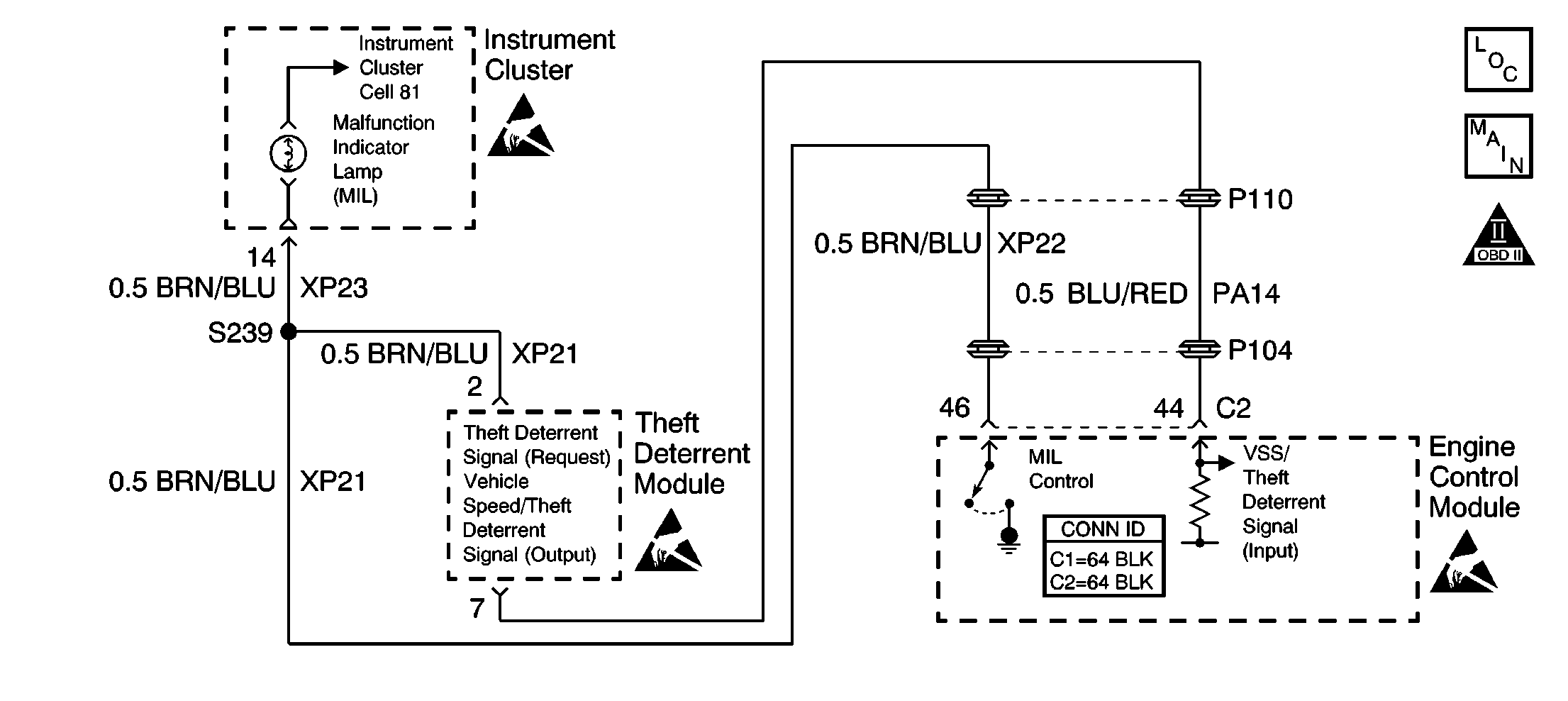
Circuit Description
This DTC sets if the ECM has not been programmed with the frequency code of the theft deterrent module, or if there is a fault in the circuit used for transmitting the data (the vehicle speed/theft deterrent signal circuit).
Conditions for Running the DTC
The engine is cranking.
Conditions for Setting the DTC
The ECM has not received the frequency code from the theft deterrent module.
Action Taken When the DTC Sets
The ECM will not illuminate the malfunction indicator lamp (MIL).
Conditions for Clearing the MIL/DTC
| • | The DTC clears after forty consecutive warm-up cycles if no failures report by this diagnostic or any other non-emission related diagnostic. |
| • | The scan tool clears the MIL/DTC. |
Diagnostic Aids
If the ECM and the theft deterrent module have not been properly programmed, this DTC may set and the vehicle will not start. Refer to Theft Deterrent System for programming instructions.
Notice: Using the J 35616-A Connector Test Adapter Kit will prevent damage to the harness connector terminals.
Use the J 35616 connector test adapter kit for any test that requires probing the ECM harness connector or a component harness connector.
Check for the following conditions:
| • | Poor connections at the ECM or at the component--Inspect the harness connectors for a poor terminal to wire connection. Refer to Engine Control Module Diagnosis , Checking Terminal Contact, for the proper procedure. |
| • | Damaged harness--Inspect the wiring harness for damage. If the harness appears to be OK, observe the scan tool while moving the related connectors and the wiring harnesses. A change in the display may help locate the fault. |
Refer to Symptoms for the Intermittents.
Test Description
The numbers below refer to the step numbers on the diagnostic table.
-
This step verifies whether or not the ECM is receiving vehicle speed data.
-
The test lamp that is connected to B+ is used to simulate the B+ pull-up within the ECM. The DMM can be connected to the shaft of the test lamp and battery ground.
Step | Action | Value(s) | Yes | No | ||||||||
|---|---|---|---|---|---|---|---|---|---|---|---|---|
1 | Did you perform the Powertrain On-Board Diagnostic (OBD) System Check? | -- | Go to Step 2 | |||||||||
Caution: Suitably chock the front wheels in order to prevent any unintended vehicle movement if only the rear of the vehicle is to be lifted in order to prevent vehicle damage and personal injury. Does the scan tool indicate a vehicle speed above the specified value? | 0.0 km/h (0.0 mph) | Go to Diagnostic Aids | Go to Step 3 | |||||||||
Does the DMM momentarily indicate frequency within the specified range? | 100-900 Hz | Go to Step 5 | Go to Step 4 | |||||||||
4 |
Did you find a problem? | -- | Go to Step 6 | Go to Step 7 | ||||||||
5 |
Does the scan tool indicate that the vehicle speed above the specified value? | 0.0 km/h (0.0 mph) | Go to Step 7 | Go to Step 8 | ||||||||
6 | Repair the vehicle speed/theft deterrent signal circuit between the theft deterrent module harness connector and the ECM. Refer to Wiring Repairs in Wiring Systems. Is the action complete? | -- | Go to Step 10 | -- | ||||||||
7 | Check for a poor connection or poor terminal tension at the theft deterrent module harness connector. Refer to Wiring Repairs in Wiring Systems. Also, refer to Checking Terminal Contact in Engine Control Module Diagnosis . Did you find and correct the problem? | -- | Go to Step 10 | |||||||||
8 | Check for a poor connection or poor terminal tension at the ECM harness connector. Refer to Wiring Repairs in Wiring Systems. Also, refer to Checking Terminal Contact in Engine Control Module Diagnosis . Did you find and correct the problem? | -- | Go to Step 10 | Go to Step 9 | ||||||||
9 |
Important: This vehicle is equipped with a theft deterrent system that interfaces with the ECM. Program the new ECM with the frequency code of the theft deterrent module that is currently on the vehicle. Replace the ECM. Refer to Engine Control Module Replacement/Programming . Is the action complete? | -- | Go to Step 10 | -- | ||||||||
10 |
Does the scan tool indicate that the diagnostic Passed? | -- | Go to Step 11 | Go to Step 2 | ||||||||
11 | Does the scan tool display any additional undiagnosed DTCs? | -- | Go to applicable DTC table | System OK |
